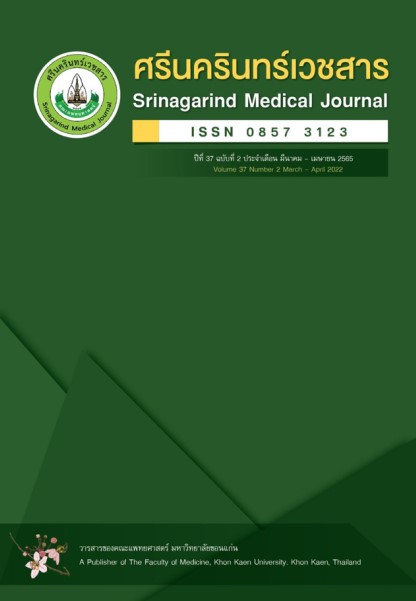ผลการใช้ค่าประมาณอัตราการกรองผ่านโกลเมอรูลัสเป็นตัวส่งสัญญาณในการเฝ้าระวังการเกิดพิษต่อไตจากยาแวนโคมัยซิน
Abstract
The Effect of the Estimated Glomerulus Filtration Rate as a Trigger Tool Model to Prevent Vancomycin Induced Nephrotoxicity
บทคัดย่อ
หลักการและวัตถุประสงค์: แวนโคมัยซิน (vancomycin) เป็นยาต้านจุลชีพที่ออกฤทธิ์กว้าง ยามีฤทธิ์ฆ่าเชื้อแบคทีเรียแกรมบวกรวมทั้ง Methicillin resistance Staphylococcus aureus (MRSA) อาการไม่พึงประสงค์สำคัญของยา vancomycin คือ การเกิดพิษต่อไต (vancomycin induced nephrotoxicity; VIN) ซึ่งเป็นอาการไม่พึงประสงค์จากยาที่สามารถป้องกันได้ โดยถ้าหากตรวจพบและแก้ไขได้อย่างรวดเร็วสามารถทำให้การทำงานของไตกลับมาเป็นปกติได้ งานวิจัยนี้มีวัตถุประสงค์เพื่อประเมินผลของการใช้ค่าประมาณอัตราการกรองผ่านโกลเมอรูลัสเป็นตัวส่งสัญญาณในการเกิดพิษต่อไตจากยา vancomycin (eGFR trigger tool) ตลอดจนศึกษาปัจจัยที่มีความสัมพันธ์ต่อการเพิ่มความเสี่ยงในการเกิดพิษต่อไต ในผู้ป่วยที่ได้รับยา vancomycin
วิธีการศึกษา: เปรียบเทียบข้อมูลก่อนและหลังทดลองใช้ระบบ eGFR trigger tool ในผู้ป่วยที่ได้รับยา vancomycin ฉีดเข้าทางหลอดเลือดดำ มาแล้วไม่ต่ำกว่า 48 ชั่วโมง ในสถาบันโรคทรวงอก โดยมีระยะเวลาช่วงละ 1 ปี คือ ระหว่างวันที่ 1 ตุลาคม พ.ศ.2560 ถึง 30 กันยายน พ.ศ.2562 ผู้ป่วยจะได้รับการติดตามจนกว่าจะหยุดใช้ยา และประเมินการเกิดพิษต่อไตจากยา โดยใช้เกณฑ์คือค่าอัตราการกรองผ่านโกลเมอรูลัส เพิ่มขึ้นมากกว่าหรือเท่ากับร้อยละ 25 ภายใน 48 ชั่วโมง หรือค่าซีรัมครีเอตินีน เพิ่มขึ้นมากกว่าหรือเท่ากับ 1.5 เท่าของค่าพื้นฐาน
ผลการศึกษา: ผู้ป่วยที่ได้รับคัดเลือกเข้าการศึกษาจำนวนทั้งหมด 366 ราย แบ่งเป็นก่อนใช้ eGFR trigger tool จำนวน 157 ราย และ หลังใช้ eGFR trigger tool จำนวน 179 ราย พบว่าก่อนใช้ eGFR trigger tool ผู้ป่วยเกิดไตวายเฉียบพลัน 54 ราย (ร้อยละ 34.4) และหลังใช้ eGFR trigger tool จำนวน 34 ราย (ร้อยละ 19) ลดลงอย่างมีนัยสำคัญเมื่อเทียบกับก่อนใช้ eGFR trigger tool (p = 0.002) และอุบัติการณ์เกิดพิษต่อไตจากยา vancomycin จะเพิ่มขึ้นอย่างมีนัยสำคัญทางสถิติ ในผู้ป่วยสูงอายุ (>70 ปี) ผู้ป่วยที่ได้รับยานานกว่า 14 วัน และผู้ป่วยที่ได้รับยา gentamycin หรือ colistin ร่วมด้วย (p = 0.012, p = 0.043, p = 0.044 และ p = 0.048 ตามลำดับ)
สรุป: หลังเริ่มใช้ค่า eGFR trigger tool พบว่าผู้ป่วยที่ได้รับยา vancomycin มีอุบัติการณ์เกิดไตวายเฉียบพลันต่ำกว่าก่อนใช้ eGFR trigger tool อย่างมีนัยสำคัญ และปัจจัยที่มีความสัมพันธ์กับการเกิดพิษต่อไตจากยา ได้แก่ ผู้ป่วยที่มีอายุมากกว่า 70 ปี ผู้ป่วยที่ได้รับยานานกว่า 14 วัน และการได้รับยาที่มีพิษต่อไตชนิดอื่นๆร่วมด้วย
คำสำคัญ: แวนโคมัยซิน ความเป็นพิษต่อไตจากยาแวนโคมัยซิน ตัวส่งสัญญาณเฝ้าระวังอาการไม่พึงประสงค์จากยา
Background and Objective: Vancomycin is a broad-spectrum antimicrobial used intravenously for the treatment of Gram-positive pathogens, including Methicillin-resistant Staphylococcus aureus (MRSA) infection. Nephrotoxicity is a commonly feared and largely preventable adverse effect of vancomycin therapy. This study aimed to determine the effect of using estimated glomerular filtration rate (eGFR) as a Trigger tool to prevent vancomycin induced nephrotoxicity and to explore potential confounding factors that may increase the risk of nephrotoxicity in patients receiving vancomycin.
Methods: This study was a retrospective study. Data were compared before and after the trial of the eGFR trigger tool system in patients receiving intravenous vancomycin for at least 48 hours in the Central Chest Institute of Thailand with a period of 1 year, during October, 2017 to September, 2019 were included. Patients will be monitored until the drug is discontinued. The incidence of nephrotoxicity, defined as a decrease in eGFR by ≥25%, and/or an increase in serum creatinine (SCr) of 1.5-fold from its baseline value.
Results: The 336 hospitalized adults treated with intravenous vancomycin at least 48 hours in hospital during October, 2017 to September, 2019 were included. There were 157 patients in before using the eGFR trigger tool group and 179 patients in after using the eGFR trigger tool group. The present study found that the incidence of acute kidney injury before and after using a eGFR trigger tool were 34.4% and 19%, respectively (p = 0.002). Elderly patients (>70 yrs.), prolonged therapy of vancomycin (>14 days), concomitant treatment with nephrotoxic agents (gentamicin and colistin) and was also associated with an increased risk of nephrotoxicity (p = 0.012, p = 0.043, p = 0.044 and p = 0.048, respectively).
Conclusions: After initiation of the eGFR trigger tool, patients treated with vancomycin had a significantly lower incidence of acute renal failure than before using the eGFR trigger tool. Factors associated with vancomycin induced nephrotoxicity included patients older than 70 years, patients treated for more than 14 days, and concomitant exposure to other nephrotoxic drugs.
Keywords: vancomycin, vancomycin induced nephrotoxicity, Adverse drug reaction trigger tool


